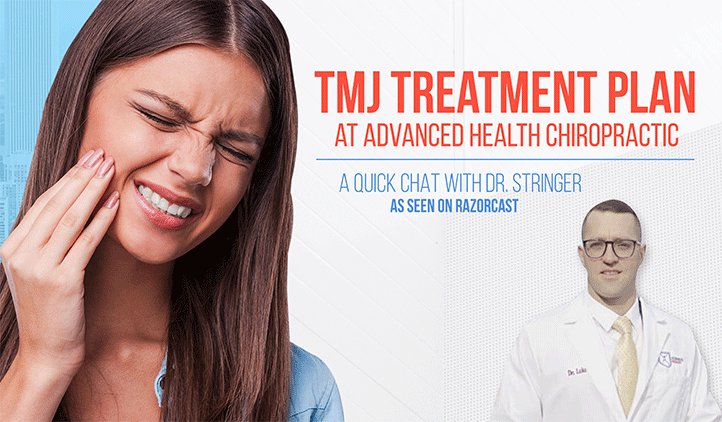At Advanced Health Chiropractic our treatment plan for TMJ is going to be a three-pronged attack.
New patients here at Advanced Health Chiropractic will fill out their intake form and they’ll provide us with a health history. Then, one of our doctors will sit down and we’ll do a really detailed consultation, based around that history, figure out when the pain started, how often it is, how it’s affecting their life, et cetera.
The first thing we need to do is evaluate joint function. We’ll perform an orthopedic evaluation. In the orthopedic evaluation, we’re going to take your spine through its range of motion, then we’re going to evaluate how well joints are moving. We’re going to look for joints that aren’t moving well. They’re creating stress and tension onto the joint and the tissue, and the nerve. We need to evaluate how those joints are moving because more often than not, if you have a subluxation, which means that joint is shifted or it’s not moving well, you’re creating stress and tension on the joint and the tissue and the nerves, right up at the cervical level. A lot of our TMJ patients are really subluxated. They’ve shifted in that upper cervical level. We would adjust that through adjustments. You need to get that joint moving.
Every joint in the body, particularly the spine, should be able to move freely and stably. The top two bones in your neck, c1, c2, Cervical 1, Cervical 2, your skull sits on top of those bones. When those bones are in alignment and moving well, all those nerves that come out of that joint go back into your head and they innervate eyes, ears, nose, throat.
Next, we’ll perform a neurologic exam, and we’ll figure out if there’s any nervous system activity, there are various tests we do for that.
Then lastly, we’re going to shoot some x-rays. In this office our diagnosis is going to be objective. When we shoot x-rays, chiropractors are going to look at them a little differently than medical doctors. Yes, we’re looking for pathology, breaks, fractures, infections, any quirky stuff like that. But we’re also, when we evaluate our x-rays, evaluating from a biomechanical standpoint. When we evaluate x-rays, we are looking for alignment. Specifically, for example, when you’re looking at the spine from the front, you should be in alignment, but if you have any lateral shifts left to right or any rotational shifts, that can create tension on the muscles, the joint, the nerves, which can also create shifts in the jaw and refer pain into that jaw. From the side, as we just discussed, top bone on top of the bottom bone, a negative 42-degree curve. As you start to lose that curve, your head is then going to start to shift forward. When it shifts forward, it creates tension to the muscle and joints shift out of alignment.
We practice chiropractic biophysics. It’s all science and data. You can objectively address those shifts through something called spinal traction. When you get your spine back into alignment, fix the joint function, and lastly, address the soft tissue changes in tissues consistently under a state of stress and tension, new postural shifts or poor alignment. The muscles are working too hard. They break down and form adhesions like glue in a muscle, it doesn’t do well. If your jaw’s out of alignment and the muscles are working too hard to try and keep you in alignment when you’re eating or talking, for example, that tissue is actually going to break down. Those adhesive changes need to be addressed too.
In our office, we can do some specific soft tissue therapy, so the muscles that sit in your jaw or your masseter, but specifically a muscle called your pterygoid. It’s really a big culprit with temporomandibular joint pain. When you address those three factors and then supplement in some postural rehab through just the upper-cross syndrome, all those big muscles that pull you forward and shift your head forward, you can get really good results with TMJ and we get awesome results with our TMJ patients.
We’ll send you home on the first day. We don’t like to treat on the first visit, simply because we don’t guess at what we do. We’ll evaluate the case. We’ll have the patient come in for the second visit and that’s when we’ll go through all our clinical findings, go through diagnostic findings, explain to the patient what’s causing their pain, and then we’ll figure out best form of treatment for that case. We’ll go through that with the patient and then we’ll get them going.
Our treatment is essentially going to involve three to four aspects, joint function through adjustments, getting the joint in alignment and moving, spinal traction, to address any structural shifts that we have in the spine, which needs to be addressed objectively, to get long-term correction. All the new research is stating that. We’ll take you through some soft tissue protocols to break down any chronic adhesive tissue, tissue that is just not healthy, doesn’t move well, it’s weak, inflexible. Then obviously, we’ll take you through a functional exam, like you would’ve done on the first day and we’ll figure out what muscles are doing too much work and which muscles aren’t doing enough work. Then, we’ll adjust those imbalances through physical therapy. When you address all those four factors, you can get really good results. That’s why we’ve got over 200 five-star Google reviews and we’re the highest-reviewed clinic in Chicago.

